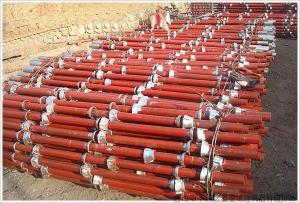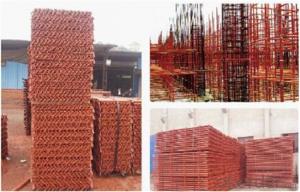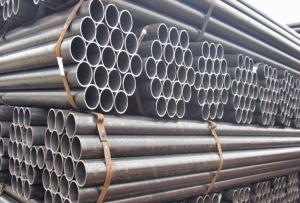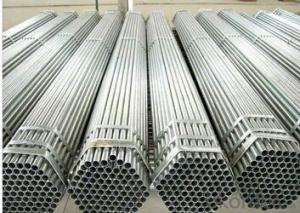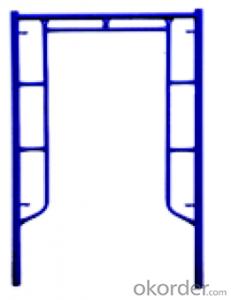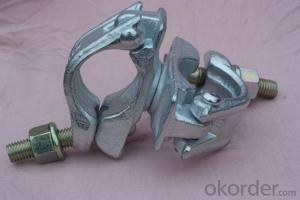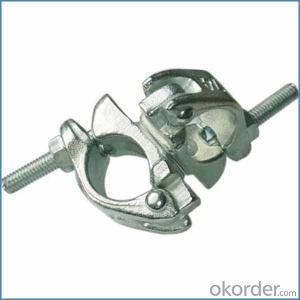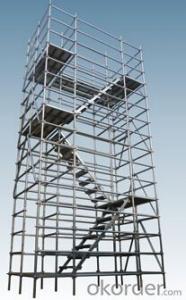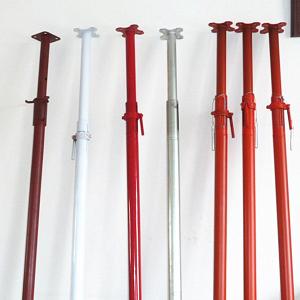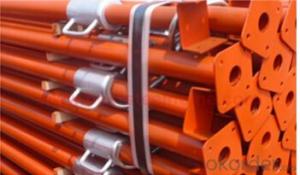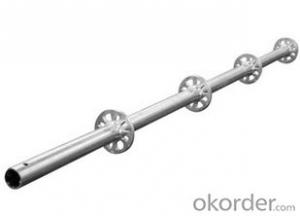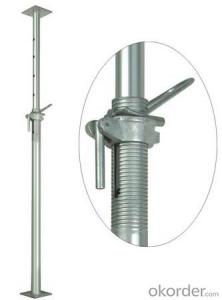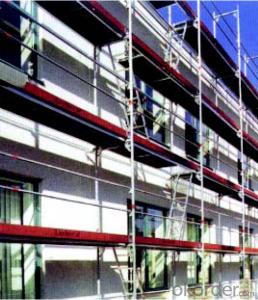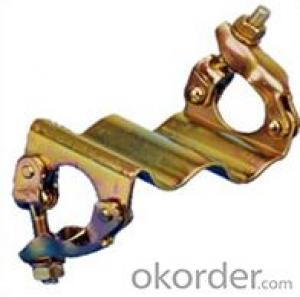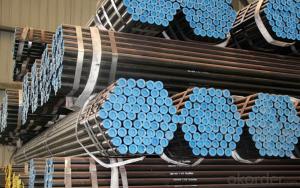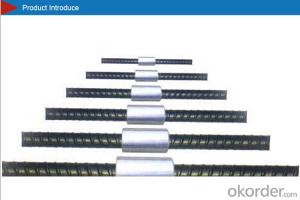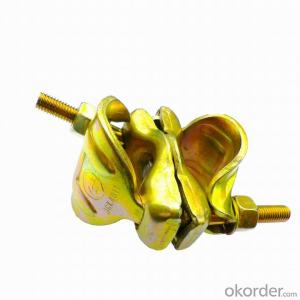Tubular Steel Shoring Prop Scaffolding for Construction
- Loading Port:
- Tianjin
- Payment Terms:
- TT or LC
- Min Order Qty:
- 600 pc
- Supply Capability:
- 40000 pc/month
OKorder Service Pledge
OKorder Financial Service
You Might Also Like
1.Structure of Cup-lock Scaffolding
Cup-lock Scaffolding consists of adapter plug of cup-lock, post, cross bar ,diagonal brace ,top bar, base and other fittings. The adapter plug of cup-lock is the core and consists of top cups, bottom cups, post ,ledger connections and limit pins of top cups. It can be widely used for industrial and civil construction and maintenance, such as workshop, large gymnasium, conference& exhibition center conversation, billboard, market, dock, tunnel, subways, etc. used for mobile working platform installation of electrical & mechanical engineering, ship repair and other decoration engineering, for building temporary stand.
2.Main Features of Cup-lock Scaffolding
Multifunction: equipments of construction with different size and load of construction could be assembled, such as one-size double-sides scaffolding, props, etc. Applied to high-rise building, bridge, water tower, and so on.
Avoid using bolt in assembly and low down labor intensity.
Reliable bending, shearing, torsional strength of dentation &cup-lock connection, the overall of it is more stable than normal.
Not easy to lose fastener, portable firm and easy to maintain and transport.
Scaffolding Light Duty Shoring prop System which is use on building as traction and pressure props.
Product Name: Scaffolding Light Duty Shoring Prop Systems.
Model Number: QS-L-1000/1700/1900/2000/2200.
3.Cup-lock Scaffolding Images
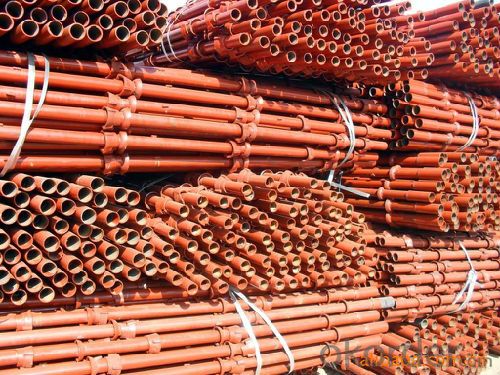
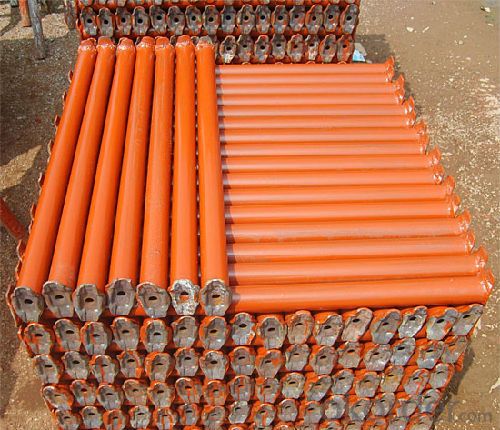
4.Cup-lock Scaffolding Specification
Feature:
1. Made By 48mm Diameter inner tube 56mm Diameter outer tube
Made By 40mm Diameter inner tube 48mm Diameter outer tube
2. Size:
1000mm(Min)--1800mm(Max)
1700mm(Min)--3000mm(Max)
1900mm(Min)--3500mm(Max)
2000mm(Min)--3600mm(Max)
3200mm(Min)--4000mm(Max)
3. Surface finish: Powder coated/Cold/Hot galvanized.
4:top/base plate:120*120*4mm or 150*150*6MM.
5.FAQ OF Cup-lock Scaffolding
What promises can be done by us?
If interested in Cup-lock Scaffolding, please feel free to write us for any QUOTE.
If printing required, please advise asap because the whole set need much more time to complete.
Please DO check goods when courier knocks your door and contact us asap if any issue.
What about of our after-sale service?
Response will be carried out in 24hours after receiving any complain or request.
Frame-Connected Scaffolding cost can be refund after order is confirmed.
If the products are not based on the requirements, there will be the relevant compensations made for you.
- Q: How do steel tube couplers compare to other types of scaffolding connectors in terms of versatility?
- Steel tube couplers are highly versatile compared to other types of scaffolding connectors. They can be used to connect tubes at various angles, allowing for flexible configurations and adaptability to different scaffold designs. Unlike other connectors, steel tube couplers can be easily adjusted and repositioned, making them suitable for complex scaffolding structures. Additionally, these couplers can be used for various scaffolding applications, such as creating straight runs, corners, or T-joints, further enhancing their versatility.
- Q: Are steel tube couplers suitable for supporting heavy loads or equipment on scaffolding?
- Steel tube couplers are a suitable option for supporting heavy loads or equipment on scaffolding. These couplers are designed specifically to securely connect two or more scaffolding tubes, offering a strong and dependable connection. Their construction enables them to withstand substantial loads and guarantee the stability and safety of the scaffolding structure. The utilization of steel tube couplers is widespread in construction and industrial environments, particularly when there is a need to support heavy equipment or loads on scaffolding. It is crucial to ensure that the installation of steel tube couplers is done correctly and that qualified professionals design and erect the scaffolding structure to guarantee its safety and stability.
- Q: Can steel tube couplers be used with different sizes of scaffolding tubes?
- Yes, steel tube couplers can be used with different sizes of scaffolding tubes. Steel tube couplers are designed to connect scaffolding tubes of various sizes securely and provide a strong and stable connection. This versatility allows for flexibility in constructing scaffolding systems using different sizes of tubes as needed.
- Q: Can steel tube couplers be used for creating cantilevered or suspended scaffolding structures?
- Yes, steel tube couplers can be used for creating cantilevered or suspended scaffolding structures. Steel tube couplers are commonly used in scaffolding systems to connect tubes together, providing a secure and stable framework for construction work. Cantilevered or suspended scaffolding structures require additional support and stability due to their unique design, and steel tube couplers can effectively meet these requirements. By securely connecting the steel tubes, the couplers ensure that the scaffolding structure remains strong and safe for workers. Additionally, steel tube couplers are versatile and can be easily adjusted or repositioned to accommodate the specific needs of a cantilevered or suspended scaffolding structure. Overall, steel tube couplers are a reliable and suitable choice for creating such scaffolding structures.
- Q: Can steel tube couplers be used in scaffolding systems with different load capacities?
- Steel tube couplers can indeed be used in scaffolding systems with different load capacities. These couplers are designed to securely connect steel tubes together, forming the structure of the scaffolding system. They are typically made from high-quality steel, ensuring strength and durability. When it comes to load capacity, it is important to consider the specific type and grade of steel tube couplers being used. Different couplers may have varying load-bearing capacities, so it is essential to select the appropriate couplers based on the expected loads in the scaffolding system. It is also crucial to ensure that the scaffolding system is designed and constructed in compliance with relevant safety standards and regulations. This includes considering factors such as the maximum load capacity of the scaffolding, the type of loads it will be subjected to (such as personnel, materials, or equipment), and any additional safety measures required. In summary, steel tube couplers can be used in scaffolding systems with different load capacities. However, it is important to carefully select couplers with appropriate load-bearing capacities and ensure compliance with safety standards to ensure the structural integrity and safety of the scaffolding system.
- Q: I want my scaffolding pierced for Christmas, I also want my nose done and more on my lobes..I no, my lobes wont hurt, How much does it hurt to get your nose and scaffolding pierced? I already have my labret done (lip) And my cartalidge done.also will I be able to use my cartalide piercing for my scaffolding or will they make another whole?
- I got my nose done if u look for answers and it says it hurts it honestly dose not pinch it self it's feels like that and ur eyes might water bit it doesn't hurt x
- Q: I just got a scaffold piercing about 5 days ago and its still really tender and slightly red is this normal?
- Yes, and it may even be too sore to sleep on as well. Just do your sea salt soaks everyday and in about a month and a half or two months it should feel normal again.
- Q: What are the common industry standards for the safe use of steel tube couplers in scaffolding?
- The safe use of steel tube couplers in scaffolding can vary depending on the country or region, with industry standards differing accordingly. However, there are widely recognized guidelines that provide instructions for the safe use of these couplers in scaffolding systems. One notable standard is the EN 74-1:2005 standard, issued by the European Committee for Standardization (CEN). This standard specifies the design, materials, dimensions, and performance requirements for steel tube couplers used in scaffolding. It also provides instructions for their safe use and maintenance. In the United States, the Occupational Safety and Health Administration (OSHA) sets regulations and standards for the safe use of scaffolding, including steel tube couplers. These standards can be found in 29 CFR 1926 Subpart L, which outlines requirements for scaffold design, construction, and use, including the use of couplers. Other countries may have their own specific standards for the safe use of steel tube couplers in scaffolding. For example, the British Standards Institution (BSI) has published the BS 1139 series, which provides guidelines for scaffolding use, including couplers, in the UK. These standards emphasize the importance of using high-quality, properly designed, and manufactured couplers that are suitable for specific applications and load requirements. They also highlight the need for proper inspection, maintenance, and training to ensure the safe use of steel tube couplers in scaffolding systems. Individuals and companies involved in scaffolding operations must be aware of and comply with applicable industry standards and regulations to ensure the safety of workers and the general public.
- Q: Are steel tube couplers resistant to vibration or shaking in scaffolding structures?
- Yes, steel tube couplers are resistant to vibration or shaking in scaffolding structures. Steel is a strong and durable material that can withstand external forces, including vibrations and shaking. Steel tube couplers are designed to provide a secure connection between scaffolding tubes, ensuring stability and integrity of the structure. These couplers are specifically engineered to minimize movement and prevent any loosening or dislodging caused by vibrations or shaking. Additionally, steel tube couplers undergo rigorous testing to ensure their resistance to various forces, including vibrations, making them a reliable choice for scaffolding structures.
- Q: How do steel tube couplers ensure the stability and rigidity of scaffolding structures during use?
- Steel tube couplers ensure the stability and rigidity of scaffolding structures during use by providing a secure and reliable connection between the individual steel tubes. These couplers are designed to join two or more tubes together at different angles, forming a strong and rigid framework that can support the weight of workers, construction materials, and equipment. One of the key features of steel tube couplers is their ability to provide a tight and secure connection. These couplers are typically made from high-quality steel and are designed to fit tightly around the tubes. They often have internal teeth or other mechanisms that grip the tubes, preventing any movement or slippage once they are tightened. This ensures that the scaffolding remains stable and rigid, even when subjected to external forces such as wind or vibrations. Furthermore, steel tube couplers distribute the load evenly across the connected tubes, which helps to enhance the overall stability of the scaffolding structure. When the weight is evenly distributed, it minimizes the risk of any individual tube or joint bearing too much pressure, reducing the chances of structural failure or collapse. This even distribution of load also allows scaffolding to support heavy loads without compromising its stability. Another advantage of steel tube couplers is their flexibility and versatility. They can be used to create various configurations and angles in scaffolding structures, allowing for the construction of customized frameworks to suit different project requirements. This flexibility ensures that the scaffolding can be adapted to different heights and shapes, while still maintaining stability and rigidity. Overall, steel tube couplers play a crucial role in ensuring the stability and rigidity of scaffolding structures during use. By providing a secure connection, distributing loads evenly, and allowing for flexibility in design, these couplers help to create safe and reliable scaffolding systems that can withstand the demands of construction sites.
Send your message to us
Tubular Steel Shoring Prop Scaffolding for Construction
- Loading Port:
- Tianjin
- Payment Terms:
- TT or LC
- Min Order Qty:
- 600 pc
- Supply Capability:
- 40000 pc/month
OKorder Service Pledge
OKorder Financial Service
Similar products
Hot products
Hot Searches
Related keywords
